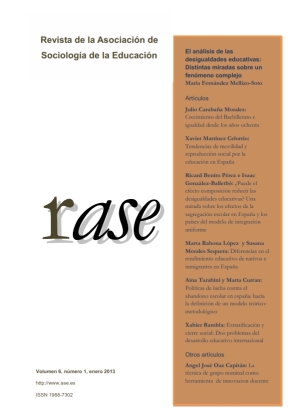Crecimiento del bachillerato e igualdad desde los años ochenta
DOI:
https://doi.org/10.7203/RASE.6.1.8595Keywords:
Baccalaureate, equal, 80´s, school growth. Abstract
Abstract
This paper has two parts. In the first one, the evolution of the rate of Bachillerato pupils is established with data from three surveys: ESD, EPA and SILC. From the mid-eighties to the mid-nineties of the past century, after it stagnated for some years after the LGE, the rate of BUP pupils grew strongly among youngsters born between 1966 and 1980. In the following period, the rate of man going to BUP decreased and the rate of women stagnated. To the growth did contribute more women than men, and more manual than non manual classes, so that both gender and class inequalities decreased. Agrarian classes did not contribute to men’s fall, so that it could be said that inequality decreased again. The second part of the paper is an attempt to explain the growth of the eighties. It is found that it was partly due to a composition effect (changes in the size of the social classes) and partly to growing class rates. This growth of class rates is explained by declines in the number of siblings and increases in parents’ schooling. These two variables account for almost all the growth in men’s class rates, leaving to future research the explanation of almost half the changes in the class rates of females.
 Downloads
Downloads
Downloads
Published
How to Cite
-
Abstract752
-
PDF (Español)433
Issue
Section
License
![]()
This work is licensed under a Creative Commons Reconocimiento-NoComercial-CompartirIgual 4.0 Internacional.




